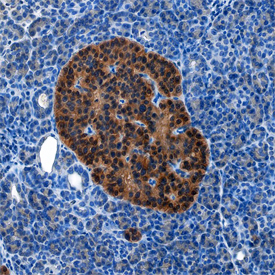Human/Mouse/Rat Complexin-1/2 Antibody Summary
Met1-Lys134
Accession # O14810
Applications
Please Note: Optimal dilutions should be determined by each laboratory for each application. General Protocols are available in the Technical Information section on our website.
Scientific Data
 View Larger
View Larger
Detection of Human, Mouse, and Rat Complexin-1/2 by Western Blot. Western blot shows lysates of human brain (cerebellum) tissue, mouse brain (cortex) tissue, and rat brain (cerebellum) tissue. PVDF membrane was probed with 0.5 µg/mL of Mouse Anti-Human/Mouse/Rat Complexin-1/2 Monoclonal Antibody (Catalog # MAB8069) followed by HRP-conjugated Anti-Mouse IgG Secondary Antibody (Catalog # HAF018). Specific bands were detected for Complexin-1/2 at approximately 17-19 kDa (as indicated). This experiment was conducted under reducing conditions and using Immunoblot Buffer Group 1.
 View Larger
View Larger
Complexin-1/2 in Human Pancreas. Complexin-1/2 was detected in immersion fixed paraffin-embedded sections of human pancreas using Mouse Anti-Human/Mouse/Rat Complexin-1/2 Monoclonal Antibody (Catalog # MAB8069) at 15 µg/mL overnight at 4 °C. Before incubation with the primary antibody, tissue was subjected to heat-induced epitope retrieval using Antigen Retrieval Reagent-Basic (Catalog # CTS013). Tissue was stained using the Anti-Mouse HRP-DAB Cell & Tissue Staining Kit (brown; Catalog # CTS002) and counterstained with hematoxylin (blue). Specific staining was localized to islets. View our protocol for Chromogenic IHC Staining of Paraffin-embedded Tissue Sections.
 View Larger
View Larger
Detection of Human Complexin-1/2 by Simple WesternTM. Simple Western lane view shows lysates of human brain (cerebellum) tissue, loaded at 0.5 mg/mL. A specific band was detected for Complexin-1/2 at approximately 23 kDa (as indicated) using 5 µg/mL of Mouse Anti-Human/Mouse/Rat Complexin-1/2 Monoclonal Antibody (Catalog # MAB8069). This experiment was conducted under reducing conditions and using the 12-230 kDa separation system. Non-specific interaction with the 230 kDa Simple Western standard may be seen with this antibody.
Reconstitution Calculator
Preparation and Storage
- 12 months from date of receipt, -20 to -70 °C as supplied.
- 1 month, 2 to 8 °C under sterile conditions after reconstitution.
- 6 months, -20 to -70 °C under sterile conditions after reconstitution.
Background: Complexin-1/2
Complexin-1 and Complexin-2 are cytosolic proteins that belongs to the complexin/synaphin family. They are expressed in select neurons and pancreatic b-cells. Complexin-1 serves as a block against premature neurotransmitter/insulin granule release. It does so by binding to the SNARE complex that contains SNAP25, VAMP2 and STX1A, generating oligomers of SNARE complexes that are optimally oriented relative to the positions of vesicle and plasma membranes. This effectively places synaptic vesicles in an optimal configuration, allowing for a coordinated, uniform fusion and release upon appropriate stimulus. Typically, complexin-1 is described as a clamp that blocks (vesicle) fusion, and the stimulus that overcomes it is one that induces an influx of synaptotagmin-detectable calcium. Both human complexin-1 and complexin-2 are 134 amino acids (aa) in length. Full-length human complexin-1 shares 84% aa sequence identity with human complexin-2. Human and mouse complexin-1 share 97% aa sequence identity, while human and mouse complexin-2 are 100% identical.
Product Datasheets
FAQs
No product specific FAQs exist for this product, however you may
View all Antibody FAQsReviews for Human/Mouse/Rat Complexin-1/2 Antibody
There are currently no reviews for this product. Be the first to review Human/Mouse/Rat Complexin-1/2 Antibody and earn rewards!
Have you used Human/Mouse/Rat Complexin-1/2 Antibody?
Submit a review and receive an Amazon gift card.
$25/€18/£15/$25CAN/¥75 Yuan/¥2500 Yen for a review with an image
$10/€7/£6/$10 CAD/¥70 Yuan/¥1110 Yen for a review without an image

